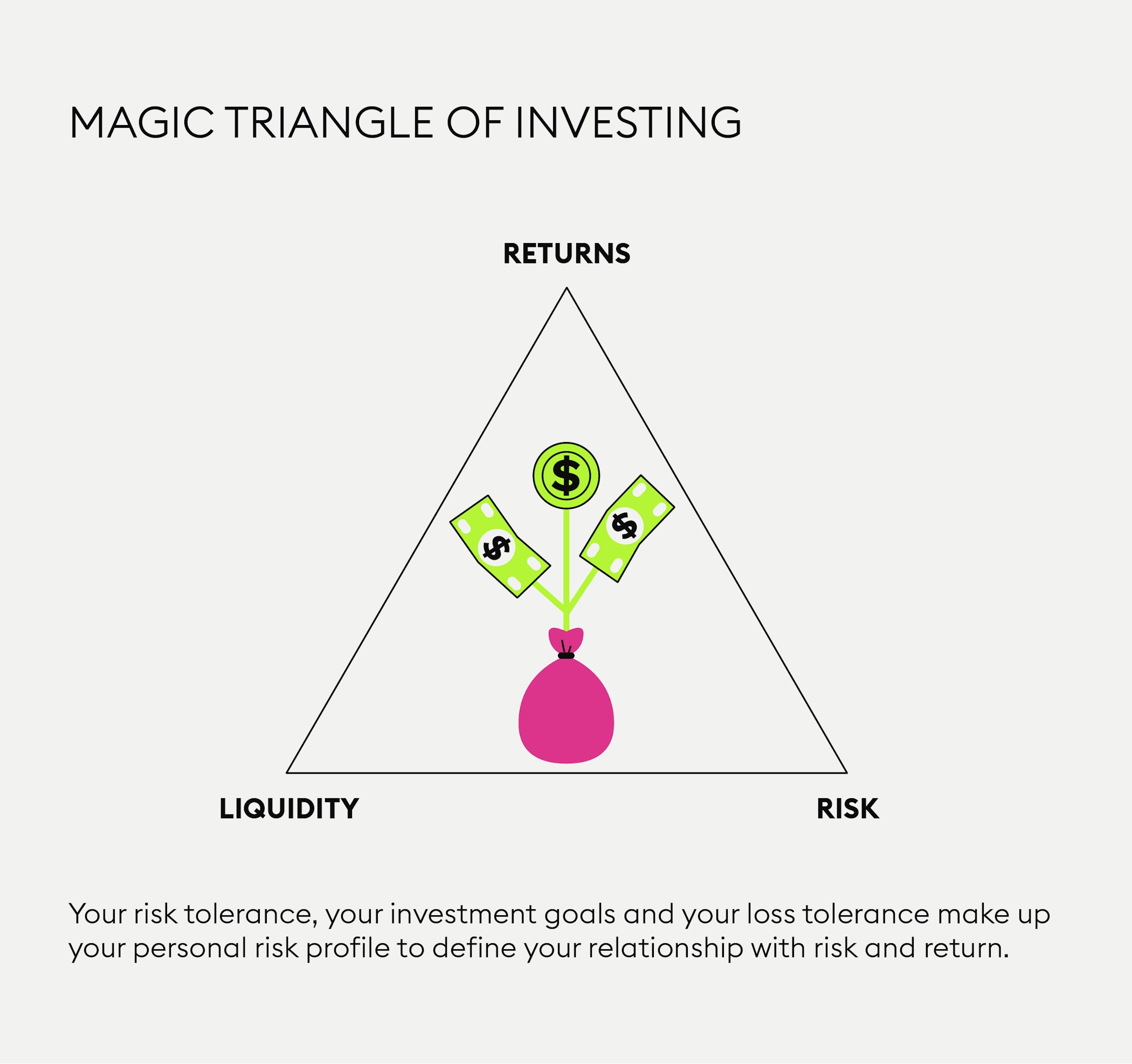
The magic triangle of investing
No matter how much investing experience you have, it’s always worth bearing the “magical triangle of investing” in mind. Also known as “the three rules of investing”, the magic triangle posits that it is not possible to achieve maximum returns at minimum risk and high liquidity with any type of investment.
Every type of investment can be analysed based on three criteria: returns, liquidity and risk, which are the three points of the investing triangle.
As an investor, you are going to attribute importance to each of these three factors depending on your personal risk profile.
One rule of thumb is that the lower the risk, the lower the returns on an investment.
Some investors believe in “buying into the dip” - buying assets when the prices are low. Others monitor mid-cap and small-cap indices for new companies in upcoming industries such as medical technology, financial technology and other innovative sectors in the hopes of high returns thanks to price gains.
Some investors also regularly offload a part of the high-performing stocks in their portfolio and re-invest in upcoming companies positioned for growth at attractive prices. Buying into large caps during times of price declines is also a popular approach. Whichever road you take, remember to always bear transaction fees and taxation of gains in mind when making calculations.
Regardless of their strategy, all investors fundamentally base their investment choices on three factors: returns, liquidity and risk.
Let’s take a look at these three factors in closer detail.
Returns
An investor’s expectation to make returns is probably the most important decision when making an investment. Returns are the income an investor receives for their investment in the form of dividend payments, value increase of a security, value increase of real estate, compound interest, etc., in the form of distributions or accumulation.
Returns are calculated based on the income generated per year in relation to the amount (the capital) invested. Novice investors often make the mistake of putting high returns ahead of all other factors before making an investment decision - however, liquidity and risk are equally important. Bear in mind that high risk investments may also mean high losses, while low-risk investments may yield lower but more solid returns.
Remember: the lower the risk of your investment, the lower your returns - while higher risks have historically yielded higher returns, they may also result in higher losses.
Liquidity
The liquidity of an investment indicates how easy or difficult it is to sell an asset at any time without noticeable effects on its market price. For instance, the market price of an asset could drop as the result of a large sell-order and you would want to sell the asset as quickly as possible without more losses. So before making an investment, consider how long it would take to sell the asset involved if you had to or wanted to sell it quickly.
The high trading volume of a stock or other securities usually indicate high liquidity. Low liquidity assets include real (tangible) assets such as art collections, real estate, businesses and any other asset entailing a complex sales process. Obviously, it usually takes a lot longer to sell a hotel than shares on a stock exchange.
Remember: The higher the liquidity, the lower the risk.
New to Bitpanda? Register your account today!
Sign up hereRisk
All investments are exposed to certain risks that you need to consider before making an investment, ranging from economic and political developments over market risks, to due diligence risks, changes in taxation laws, and so on.
It is always easy to admire seasoned investors with a lot of experience that generate high returns on their investments without seemingly any effort. More likely than not, however, it took them a few years to learn the ropes. While diversifying assets is a vital measure to counterbalance risk loss, don’t forget that high-risk investments may yield high earnings but also result in high losses. Please also remember that no matter the investment, there is always a chance that you could lose your entire expenditure.
Derivatives are a type of high risk investment. They are contracts that derive their value from the performance of an underlying security in the future (futures) or stock performance (stock options). Other types of high-risk investments include cryptocurrencies, crowdfunding (online fundraising for a venture with small investments from many parties), and investments in small caps in up-and-coming industries, just to name a few.
Remember: The higher the risk of your investment, the higher your returns and the higher your losses in case the investment doesn’t go according to plan. The lower the risk of your investment, the smaller the chance of high returns.
DISCLAIMER
This article does not constitute investment advice, nor is it an offer or invitation to purchase any crypto assets.
This article is for general purposes of information only and no representation or warranty, either expressed or implied, is made as to, and no reliance should be placed on, the fairness, accuracy, completeness or correctness of this article or opinions contained herein.
Some statements contained in this article may be of future expectations that are based on our current views and assumptions and involve uncertainties that could cause actual results, performance or events which differ from those statements.
None of the Bitpanda GmbH nor any of its affiliates, advisors or representatives shall have any liability whatsoever arising in connection with this article.
Please note that an investment in crypto assets carries risks in addition to the opportunities described above.
